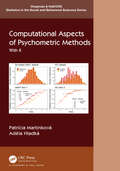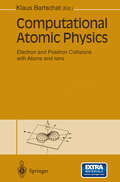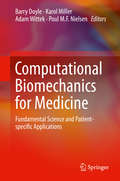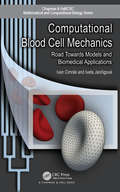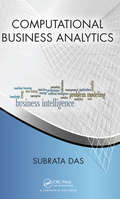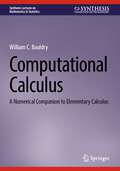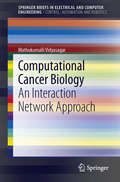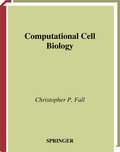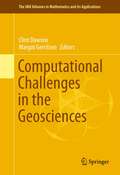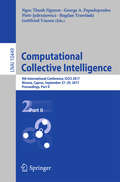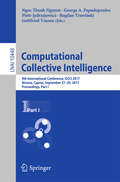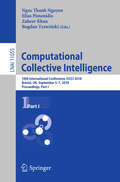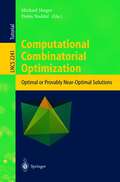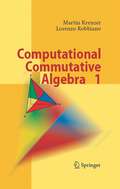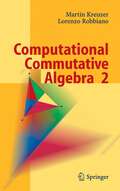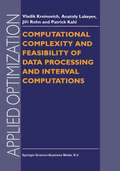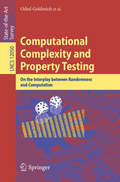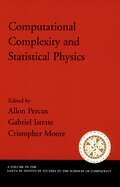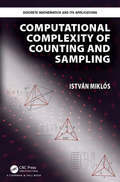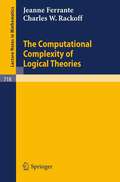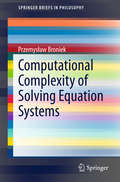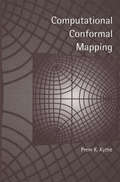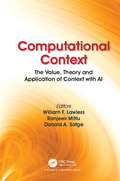- Table View
- List View
Computational Aspects of Psychometric Methods: With R (Chapman & Hall/CRC Statistics in the Social and Behavioral Sciences)
by Patricia Martinková Adéla HladkáThis book covers the computational aspects of psychometric methods involved in developing measurement instruments and analyzing measurement data in social sciences. It covers the main topics of psychometrics such as validity, reliability, item analysis, item response theory models, and computerized adaptive testing. The computational aspects comprise the statistical theory and models, comparison of estimation methods and algorithms, as well as an implementation with practical data examples in R and also in an interactive ShinyItemAnalysis application. Key Features: Statistical models and estimation methods involved in psychometric research Includes reproducible R code and examples with real datasets Interactive implementation in ShinyItemAnalysis application The book is targeted toward a wide range of researchers in the field of educational, psychological, and health-related measurements. It is also intended for those developing measurement instruments and for those collecting and analyzing data from behavioral measurements, who are searching for a deeper understanding of underlying models and further development of their analytical skills.
Computational Atomic Physics: Electron and Positron Collisions with Atoms and Ions
by K. Bartschat I. E. McCarthy R. P. McEachran D. H Madison Z. XixiangComputational Atomic Physics deals with computational methods for calculating electron (and positron) scattering from atoms and ions, including elastic scattering, excitation, and ionization processes. Each chapter is divided into abstract, theory, computer program with sample input and output, summary, suggested problems, and references. An MS-DOS diskette is included, which holds 11 programs covering the features of each chapter and therefore contributing to a deeper understanding of the field. Thus the book provides a unique practical application of advanced quantum mechanics.
Computational Biomechanics for Medicine: Fundamental Science and Patient-specific Applications
by Barry Doyle Karol Miller Adam Wittek Poul M. F. NielsenOne of the greatest challenges facing the computational engineering community is to extend the success of computational mechanics to fields outside traditional engineering, in particular to biology, the biomedical sciences and medicine. The Computational Biomechanics for Medicine series provides an opportunity for specialists in computational biomechanics to present their latest methodologies and advancements. This 5th edition comprises nine of the latest developments in both fundamental science and patient-specific applications, from researchers in Australia, New Zealand, USA, UK, France, Ireland and China. Some of the interesting topics discussed are: cellular mechanics; tumor growth and modeling; medical image analysis and both patient-specific fluid dynamics and solid mechanic simulations.
Computational Blood Cell Mechanics: Road Towards Models and Biomedical Applications (Chapman & Hall/CRC Computational Biology Series)
by Ivan Cimrak Iveta JancigovaSimulating blood cells for biomedical applications is a challenging goal. Whether you want to investigate blood flow behavior on the cell scale, or use a blood cell model for fast computational prototyping in microfluidics, Computational Blood Cell Mechanics will help you get started, and show you the path forward. The text presents a step-by-step approach to cell model building that can be adopted when developing and validating models for biomedical applications, such as filtering and sorting cells, or examining flow and deformations of individual cells under various conditions. It starts with basic building-blocks that, together, model the red blood cell membrane according to its physical properties, before moving on to discuss several issues that may pose problems along the way, and finally leads to suggestions on how to set up computational experiments. More details available at www.compbloodcell.eu
Computational Blood Cell Mechanics: Road Towards Models and Biomedical Applications (Chapman & Hall/CRC Computational Biology Series)
by Ivan Cimrak Iveta JancigovaSimulating blood cells for biomedical applications is a challenging goal. Whether you want to investigate blood flow behavior on the cell scale, or use a blood cell model for fast computational prototyping in microfluidics, Computational Blood Cell Mechanics will help you get started, and show you the path forward. The text presents a step-by-step approach to cell model building that can be adopted when developing and validating models for biomedical applications, such as filtering and sorting cells, or examining flow and deformations of individual cells under various conditions. It starts with basic building-blocks that, together, model the red blood cell membrane according to its physical properties, before moving on to discuss several issues that may pose problems along the way, and finally leads to suggestions on how to set up computational experiments. More details available at www.compbloodcell.eu
Computational Business Analytics: Computational Business Analytics
by Subrata DasLearn How to Properly Use the Latest Analytics Approaches in Your OrganizationComputational Business Analytics presents tools and techniques for descriptive, predictive, and prescriptive analytics applicable across multiple domains. Through many examples and challenging case studies from a variety of fields, practitioners easily see the connections
Computational Calculus: A Numerical Companion to Elementary Calculus (Synthesis Lectures on Mathematics & Statistics)
by William C. BauldryThis book offers readers the methods that are necessary to apply the power of calculus to analyze real problems. While most calculus textbooks focus on formula-based calculus, this book explains how to do the analysis of calculus, rates of change, and accumulation from data. The author’s introductory approach prepares students with the techniques to handle numerically-based problems in more advanced classes or in real-world applications. This self-contained book uses the computer algebra system Maple for computation, and the material is easily adaptable for calculators or other computer algebra systems. The author includes historical context and example exercises throughout the book in order to provide readers with a thorough understanding of the topic. This book:Prepares students with the techniques to handle numerically-based problems in in real-world applicationsProvides historical context and example exercises to give a thorough understanding of the topicUtilizes Maple for computation and is adaptable for calculators or other computer algebra systems
Computational Cancer Biology: An Interaction Network Approach (SpringerBriefs in Electrical and Computer Engineering)
by Mathukumalli VidyasagarThis brief introduces people with a basic background in probability theory to various problems in cancer biology that are amenable to analysis using methods of probability theory and statistics. The title mentions “cancer biology” and the specific illustrative applications reference cancer data but the methods themselves are more broadly applicable to all aspects of computational biology. Aside from providing a self-contained introduction to basic biology and to cancer, the brief describes four specific problems in cancer biology that are amenable to the application of probability-based methods. The application of these methods is illustrated by applying each of them to actual data from the biology literature. After reading the brief, engineers and mathematicians should be able to collaborate fruitfully with their biologist colleagues on a wide variety of problems.
Computational Cell Biology (Interdisciplinary Applied Mathematics #20)
by Christopher P. Fall Eric S. Marland John M. Wagner John J. TysonThis textbook provides an introduction to dynamic modeling in molecular cell biology, taking a computational and intuitive approach. Detailed illustrations, examples, and exercises are included throughout the text. Appendices containing mathematical and computational techniques are provided as a reference tool.
Computational Challenges in the Geosciences (The IMA Volumes in Mathematics and its Applications #156)
by Clint Dawson and Margot GerritsenComputational Challenges in the Geosciences addresses a cross-section of grand challenge problems arising in geoscience applications, including groundwater and petroleum reservoir simulation, hurricane storm surge, oceanography, volcanic eruptions and landslides, and tsunamis. Each of these applications gives rise to complex physical and mathematical models spanning multiple space-time scales, which can only be studied through computer simulation. The data required by the models is often highly uncertain, and the numerical solution of the models requires sophisticated algorithms which are mathematically accurate, computationally efficient and yet must preserve basic physical properties of the models. This volume summarizes current methodologies and future research challenges in this broad and important field.
Computational Collective Intelligence: 9th International Conference, ICCCI 2017, Nicosia, Cyprus, September 27-29, 2017, Proceedings, Part II (Lecture Notes in Computer Science #10449)
by Ngoc Thanh Nguyen George A. Papadopoulos Piotr Jędrzejowicz Bogdan Trawiński Gottfried VossenThis two-volume set (LNAI 10448 and LNAI 10449) constitutes the refereed proceedings of the 9th International Conference on Collective Intelligence, ICCCI 2017, held in Nicosia, Cyprus, in September 2017. The 117 full papers presented were carefully reviewed and selected from 248 submissions. The conference focuseson the methodology and applications of computational collective intelligence, included: multi-agent systems, knowledge engineering and semantic web, social networks and recommender systems, text processing and information retrieval, data mining methods and applications, sensor networks and internet of things, decision support & control systems, and computer vision techniques.
Computational Collective Intelligence: 9th International Conference, ICCCI 2017, Nicosia, Cyprus, September 27-29, 2017, Proceedings, Part I (Lecture Notes in Computer Science #10448)
by Ngoc Thanh Nguyen George A. Papadopoulos Piotr Jędrzejowicz Bogdan Trawiński Gottfried VossenThis two-volume set (LNAI 10448 and LNAI 10449) constitutes the refereed proceedings of the 9th International Conference on Collective Intelligence, ICCCI 2017, held in Nicosia, Cyprus, in September 2017. The 117 full papers presented were carefully reviewed and selected from 248 submissions. The conference focuseson the methodology and applications of computational collective intelligence, included: multi-agent systems, knowledge engineering and semantic web, social networks and recommender systems, text processing and information retrieval, data mining methods and applications, sensor networks and internet of things, decision support & control systems, and computer vision techniques.
Computational Collective Intelligence: 10th International Conference, ICCCI 2018, Bristol, UK, September 5-7, 2018, Proceedings, Part I (Lecture Notes in Computer Science #11055)
by Ngoc Thanh Nguyen Elias Pimenidis Zaheer Khan Bogdan TrawińskiThis two-volume set (LNAI 11055 and LNAI 11056) constitutes the refereed proceedings of the 10th International Conference on Collective Intelligence, ICCCI 2018, held in Bristol, UK, in September 2018 The 98 full papers presented were carefully reviewed and selected from 240 submissions. The conference focuses on knowledge engineering and semantic web, social network analysis, recommendation methods and recommender systems, agents and multi-agent systems, text processing and information retrieval, data mining methods and applications, decision support and control systems, sensor networks and internet of things, as well as computer vision techniques.
Computational Combinatorial Optimization: Optimal or Provably Near-Optimal Solutions (Lecture Notes in Computer Science #2241)
by Michael Jünger Denis NaddefThis tutorial contains written versions of seven lectures on Computational Combinatorial Optimization given by leading members of the optimization community. The lectures introduce modern combinatorial optimization techniques, with an emphasis on branch and cut algorithms and Lagrangian relaxation approaches. Polyhedral combinatorics as the mathematical backbone of successful algorithms are covered from many perspectives, in particular, polyhedral projection and lifting techniques and the importance of modeling are extensively discussed. Applications to prominent combinatorial optimization problems, e.g., in production and transport planning, are treated in many places; in particular, the book contains a state-of-the-art account of the most successful techniques for solving the traveling salesman problem to optimality.
Computational Commutative Algebra 1
by Martin Kreuzer Lorenzo RobbianoThis introduction to polynomial rings, Gröbner bases and applications bridges the gap in the literature between theory and actual computation. It details numerous applications, covering fields as disparate as algebraic geometry and financial markets. To aid in a full understanding of these applications, more than 40 tutorials illustrate how the theory can be used. The book also includes many exercises, both theoretical and practical.
Computational Commutative Algebra 2
by Martin Kreuzer Lorenzo Robbiano"The second volume of the authors’ ‘Computational commutative algebra’…covers on its 586 pages a wealth of interesting material with several unexpected applications. … an encyclopedia on computational commutative algebra, a source for lectures on the subject as well as an inspiration for seminars. The text is recommended for all those who want to learn and enjoy an algebraic tool that becomes more and more relevant to different fields of applications." --ZENTRALBLATT MATH
Computational Complexity and Feasibility of Data Processing and Interval Computations (Applied Optimization #10)
by V. Kreinovich A.V. Lakeyev J. Rohn P.T. KahlTargeted audience • Specialists in numerical computations, especially in numerical optimiza tion, who are interested in designing algorithms with automatie result ver ification, and who would therefore be interested in knowing how general their algorithms caIi in principle be. • Mathematicians and computer scientists who are interested in the theory 0/ computing and computational complexity, especially computational com plexity of numerical computations. • Students in applied mathematics and computer science who are interested in computational complexity of different numerical methods and in learning general techniques for estimating this computational complexity. The book is written with all explanations and definitions added, so that it can be used as a graduate level textbook. What this book .is about Data processing. In many real-life situations, we are interested in the value of a physical quantity y that is diflicult (or even impossible) to measure directly. For example, it is impossible to directly measure the amount of oil in an oil field or a distance to a star. Since we cannot measure such quantities directly, we measure them indirectly, by measuring some other quantities Xi and using the known relation between y and Xi'S to reconstruct y. The algorithm that transforms the results Xi of measuring Xi into an estimate fj for y is called data processing.
Computational Complexity and Property Testing: On the Interplay Between Randomness and Computation (Lecture Notes in Computer Science #12050)
by Itai Benjamini Scott Decatur Maya Leshkowitz Or Meir Dana Ron Guy Rothblum Avishay Tal Liav Teichner Roei Tell Avi WigdersonThis volume contains a collection of studies in the areas of complexity theory and property testing. The 21 pieces of scientific work included were conducted at different times, mostly during the last decade. Although most of these works have been cited in the literature, none of them was formally published before. Within complexity theory the topics include constant-depth Boolean circuits, explicit construction of expander graphs, interactive proof systems, monotone formulae for majority, probabilistically checkable proofs (PCPs), pseudorandomness, worst-case to average-case reductions, and zero-knowledge proofs.Within property testing the topics include distribution testing, linearity testing, lower bounds on the query complexity (of property testing), testing graph properties, and tolerant testing. A common theme in this collection is the interplay between randomness and computation.
Computational Complexity and Statistical Physics (Santa Fe Institute Studies on the Sciences of Complexity)
by Allon Percus Gabriel Istrate Cristopher MooreComputer science and physics have been closely linked since the birth of modern computing. In recent years, an interdisciplinary area has blossomed at the junction of these fields, connecting insights from statistical physics with basic computational challenges. Researchers have successfully applied techniques from the study of phase transitions to analyze NP-complete problems such as satisfiability and graph coloring. This is leading to a new understanding of the structure of these problems, and of how algorithms perform on them. Computational Complexity and Statistical Physics will serve as a standard reference and pedagogical aid to statistical physics methods in computer science, with a particular focus on phase transitions in combinatorial problems. Addressed to a broad range of readers, the book includes substantial background material along with current research by leading computer scientists, mathematicians, and physicists. It will prepare students and researchers from all of these fields to contribute to this exciting area.
Computational Complexity of Counting and Sampling (Discrete Mathematics and Its Applications)
by Istvan MiklosComputational Complexity of Counting and Sampling provides readers with comprehensive and detailed coverage of the subject of computational complexity. It is primarily geared toward researchers in enumerative combinatorics, discrete mathematics, and theoretical computer science. The book covers the following topics: Counting and sampling problems that are solvable in polynomial running time, including holographic algorithms; #P-complete counting problems; and approximation algorithms for counting and sampling. First, it opens with the basics, such as the theoretical computer science background and dynamic programming algorithms. Later, the book expands its scope to focus on advanced topics, like stochastic approximations of counting discrete mathematical objects and holographic algorithms. After finishing the book, readers will agree that the subject is well covered, as the book starts with the basics and gradually explores the more complex aspects of the topic. Features: Each chapter includes exercises and solutions Ideally written for researchers and scientists Covers all aspects of the topic, beginning with a solid introduction, before shifting to computational complexity’s more advanced features, with a focus on counting and sampling
Computational Complexity of Counting and Sampling (Discrete Mathematics and Its Applications)
by Istvan MiklosComputational Complexity of Counting and Sampling provides readers with comprehensive and detailed coverage of the subject of computational complexity. It is primarily geared toward researchers in enumerative combinatorics, discrete mathematics, and theoretical computer science. The book covers the following topics: Counting and sampling problems that are solvable in polynomial running time, including holographic algorithms; #P-complete counting problems; and approximation algorithms for counting and sampling. First, it opens with the basics, such as the theoretical computer science background and dynamic programming algorithms. Later, the book expands its scope to focus on advanced topics, like stochastic approximations of counting discrete mathematical objects and holographic algorithms. After finishing the book, readers will agree that the subject is well covered, as the book starts with the basics and gradually explores the more complex aspects of the topic. Features: Each chapter includes exercises and solutions Ideally written for researchers and scientists Covers all aspects of the topic, beginning with a solid introduction, before shifting to computational complexity’s more advanced features, with a focus on counting and sampling
The Computational Complexity of Logical Theories (Lecture Notes in Mathematics #718)
by J. Ferrante C. W. RackoffComputational Complexity of Solving Equation Systems (SpringerBriefs in Philosophy)
by Przemysław BroniekThis volume considers the computational complexity of determining whether a system of equations over a fixed algebra A has a solution. It examines in detail the two problems this leads to: SysTermSat(A) and SysPolSat(A), in which equations are built out of terms or polynomials, respectively. The book characterizes those algebras for which SysPolSat can be solved in a polynomial time. So far, studies and their outcomes have not covered algebras that generate a variety admitting type 1 in the sense of Tame Congruence Theory. Since unary algebras admit only type 1, this book focuses on these algebras to tackle the main problem. It discusses several aspects of unary algebras and proves that the Constraint Satisfaction Problem for relational structures is polynomially equivalent to SysTermSat over unary algebras. The book’s final chapters discuss partial characterizations, present conclusions, and describe the problems that are still open.
Computational Context: The Value, Theory and Application of Context with AI
by William F. Lawless Ranjeev Mittu Donald SofgeThis volume addresses context from three comprehensive perspectives: first, its importance, the issues surrounding context, and its value in the laboratory and the field; second, the theory guiding the AI used to model its context; and third, its applications in the field (e.g., decision-making). This breadth poses a challenge. The book analyzes how the environment (context) influences human perception, cognition and action. While current books approach context narrowly, the major contribution of this book is to provide an in-depth review over a broad range of topics for a computational context no matter its breadth. The volume outlines numerous strategies and techniques from world-class scientists who have adapted their research to solve different problems with AI, in difficult environments and complex domains to address the many computational challenges posed by context. Context can be clear, uncertain or an illusion. Clear contexts: A father praising his child; a trip to the post office to buy stamps; a policewoman asking for identification. Uncertain contexts: A sneak attack; a surprise witness in a courtroom; a shout of "Fire! Fire!" Contexts as illusion: Humans fall prey to illusions that machines do not (Adelson’s checkerboard illusion versus a photometer). Determining context is not easy when disagreement exists, interpretations vary, or uncertainty reigns. Physicists like Einstein (relativity), Bekenstein (holographs) and Rovelli (universe) have written that reality is not what we commonly believe. Even outside of awareness, individuals act differently whether alone or in teams. Can computational context with AI adapt to clear and uncertain contexts, to change over time, and to individuals, machines or robots as well as to teams? If a program automatically "knows" the context that improves performance or decisions, does it matter whether context is clear, uncertain or illusory? Written and edited by world class leaders from across the field of autonomous systems research, this volume carefully considers the computational systems being constructed to determine context for individual agents or teams, the challenges they face, and the advances they expect for the science of context.
